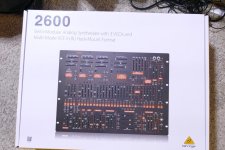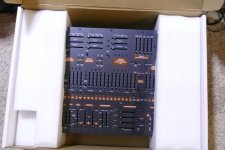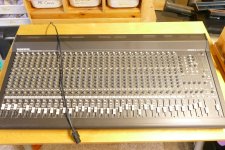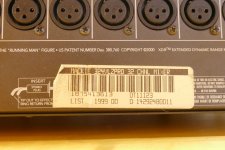The Hammond organ tech I was occasionally hanging out with when I was in high school had one. I remember the S/H was just stunning to me back then, I thought I was hearing "Wont get Fooled Again" as I moved the slider! Or at least caught a glimpse of how those sounds were done.I got to play with a newly released ARP 2600 at the University of Miami in 1972 for a few days
Later in college I attempted a S/H within the loop filter of a CD4046, taking advantage of its oscillators hi-Z input and a Tantalum cap. I used one of the early cmos analog switches. My aim was to have it lock on to a guitar note, then sustain it for long after the note decayed away. It never worked. I even dug up a delay line so there'd be a few cycles left coming in when the gate closed.
It's good to understand the concepts, even if you can never quite get it to work as imagined.
I hacked mine: made an audio in interface and then connected that to the 8 VCFs -> VCAs.The Korg DW-8000 died long ago and was parted out.
Then I can plug my Kurzweil K2500 individual outs into these for a massively powerful custom Polyphonic Hybrid Synth.
The Behringer Modular stuff will save me some DIY time. They're quite affordable, and hence, I should have more music-making time.
At least that's the theory. In practice, I am doing a lot of deep V.A.S.T. programming on the Kurzweil, but also eyeing some audio DIY Projects again (amplifier, mixer, PSU, etc...)
Well, the "shiny new object syndrome" won out and I now have a Behringer 2600 sitting in its box saying "play with me." Unfortunately it won't fit where I planned to put it. This triggered the "rip the whole studio up and rebuild it," event that's been necessary for some time. The old Roland JV-880 has been standing on its edge for a few years because it's too deep to fit in the rack. There is a finished and tested T-synth that has no home and a PROGUE that is built, but did not work due to a counterfeit chip. I now have a genuine chip, but have not swapped it due to lack of space. The rather large MFOS Ultimate, and Ultimate Expanders are both built and tested, but need considerable space. Not to mention the large by huge by heavy Roland JV-1000 that has been sleeping in its road case since I repaired it here in post #3099:I do still have my Roland JV-880 and JV-1000. The Korg DW-8000 died long ago and was parted out.
Now while my "Eurorack system" holds 4 complete Behringer synths plus a few modules, Behringer just dangled another piece of bait in front of me which makes it too easy to add a whole bunch more functionality for a reasonable price. I don't know if I can resist a 2600 clone for $419. I got to play with a newly released ARP 2600 at the University of Miami in 1972 for a few days before I would leave my job at an Olson Electronics store next to the U of M for a career 40 miles to the north. I never saw the U of M or the 2600 again. Could I have $420 worth of fun with a clone? You bet!
https://www.diyaudio.com/community/threads/what-did-you-last-repair.313739/page-155
Somewhere between 5 and 10 hamfests ago I bought a larger by huger by heavier Mackie 32 input 4 bus mixing console still wearing it's $2000 price tag for $100. My guess is that it has some issues, but it lights up and doesn't smoke. Where will all this fun stuff go?
Attachments
Was reconnecting with some of my older synths: the Roland JX-3P that I hacked heavily and the Korg DW-8000 which I also hacked heavily. I also listened to some videos on YT demonstrating both and this has started bugging me greatly:
1. The JX-3P (and my JX-8P also has that quality) has a 'metallic' character to its overall sound
2. The Korg DW-8000 has a 'plastic' veil over all of its sound.
These characteristics are there despite various mods along the signal path. Therefore, I think it probably has to do with either the filter circuit and the mixing of voices and/or the interplay between the Digital sections and the Analogue sections.
Worth a deeper look to check whether something is noticeable and can be done.
I route CV and Audio among all my gear in a Meta-Modular setup as far as I can.
1. The JX-3P (and my JX-8P also has that quality) has a 'metallic' character to its overall sound
2. The Korg DW-8000 has a 'plastic' veil over all of its sound.
These characteristics are there despite various mods along the signal path. Therefore, I think it probably has to do with either the filter circuit and the mixing of voices and/or the interplay between the Digital sections and the Analogue sections.
Worth a deeper look to check whether something is noticeable and can be done.
I route CV and Audio among all my gear in a Meta-Modular setup as far as I can.
Power Supply?These characteristics are there despite various mods along the signal path. Therefore, I think it probably has to do with either the filter circuit and the mixing of voices and/or the interplay between the Digital sections and the Analogue sections.
My modular machine is expanding uncontrollable. Salvaged some plywood from the dump the workers changing the roof has put in the yard to add more space.
Got home from USA a month ago with more of Barton's moduls:
2 x Panner
1 x VC Distortion
1 x MIDI2VC
1 x Graphic Envelope Generator
And as usual, ordered "ALL" components to these kits and missed a few here and there.
Got home from USA a month ago with more of Barton's moduls:
2 x Panner
1 x VC Distortion
1 x MIDI2VC
1 x Graphic Envelope Generator
And as usual, ordered "ALL" components to these kits and missed a few here and there.
I was glansing thru some copies from journals the other evening and (finally) found a description of a device similar to the GEG, but this thing was a free-running thing with potentiometers setting the waveshape. When Barton constructed his device I had to get it.
I have some ideas to make my synth slightly stereophoney and it would bee fun to be able to pan signals between the channels, hence the two VC panners.
I have some ideas to make my synth slightly stereophoney and it would bee fun to be able to pan signals between the channels, hence the two VC panners.
Sounds like quad to me; one left right, the other front back. Spin that sound like a horsefly interested in your hair... Maybe you'd need three?the two VC panners.
- Home
- Live Sound
- Instruments and Amps
- Modular Synth build



